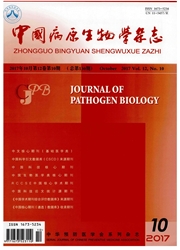

 中文摘要:
中文摘要:
目的观察旋毛虫幼虫侵入前后小鼠肠上皮细胞蛋白的变化,筛选幼虫侵入相关蛋白。方法将旋毛虫感染性幼虫接种至小鼠小肠上皮细胞(intestinal epithelial cells,IECs)单层,于37℃5%CO2条件下培养2h,提取细胞蛋白,进行SDS-PAGE与Western blot分析,并与正常IECs细胞蛋白比较。结果SDS-PAGE分析表明,IECs与感染性幼虫共孵育后的IECs蛋白带数为44条,与正常IECs对照组的相同;Western blot显示,正常IECs蛋白不能被旋毛虫感染鼠血清识别,与幼虫共孵育后的IECs蛋白有16个组分带能被旋毛虫感染鼠血清识别,分子质量单位分别为125、118、106、98、70、64、50、47、46、40、34、33、31、29、27、26ku。结论小鼠IECs与旋毛虫幼虫共培养可产生能被旋毛虫感染鼠血清识别的细胞蛋白,该组蛋白可能是旋毛虫侵入相关蛋白。
 英文摘要:
英文摘要:
Objectives To observe changes in cell proteins after invasion of intestinal epithelial cells (IECs) by infective Trichinella spiralis larvae and to screen for invasion-related proteins. Methods Infective T. spiralis larvae were seeded on a monolayer of IECs and then cultured at 37℃ in 50%CO2 for 2 h. The cell proteins were extracted and analyzed using SDS-PAGE and Western blotting. Results The results of SDS-PAGE revealed that the protein band (44 ku) in IECs cultured with infective larvae was the same as in normal IECs cultured only in medium. Western blot analysis re vealed that normal IECs proteins were not recognized by sera from mice infected with T. spiralis. Sixteen protein bands (125, 118, 106, 98, 70, 64, 50, 47, 46, 40, 34, 33, 31, 29, 27, and 26 ku) in IECs cultured with infective larvae were recognized by sera from mice infected with T. spiralis. Conclusion Proteins in cells recognized by sera from mice infected with T. spiralis were produced after IECs were co-cultured with larvae. These proteins may be the invasion-related proteins of T. spiralis.
 同期刊论文项目
同期刊论文项目
 同项目期刊论文
同项目期刊论文
 Normal Mouse Intestinal Epithelial Cells as a Model for the in vitro Invasion of Trichinella spirali
Normal Mouse Intestinal Epithelial Cells as a Model for the in vitro Invasion of Trichinella spirali 期刊信息
期刊信息
